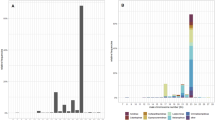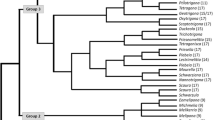Abstract
We analyze the prevalence of B chromosomes in 1,601 species of orthopteran insects where chromosome number and shape are known. B chromosomes have been reported in 191 of these species. Bs are not uniformly distributed among orthopteran superfamilies, with evident hotspots in the Pyrgomorphoidea (32.3% of species carrying Bs), Grylloidea (14.9%), Acridoidea (14.6%) and Tetrigoidea (14.3%). As expected under the theory of centromeric drive, we found a correlation between B chromosome presence and A chromosome shape—Bs are more frequent in karyotypes with more acrocentric A chromosomes. We also found that Bs are less common in species with high chromosome numbers and appear to be most common at the modal chromosome number (2n = 24). Study effort, measured for each genus, was not associated with B prevalence, A chromosome shape or A chromosome number. Our results thus provide support for centromeric drive as an important and prevalent force in the karyotypic evolution of Orthoptera, just as it appears to be in mammals. We suggest that centromeric drive may provide a mechanistic explanation for White’s principle of karyotypic orthoselection.



Similar content being viewed by others
References
Bakkali M, Perfectti F, Camacho JPM (2002) The B chromosome polymorphism of the grasshopper Eyprepocnemis plorans in North Africa. II. Parasitic and neutralized B1 chromosomes. Heredity 88:14–18
Bidau CJ, Martí DA (2004) B chromosomes and Robertsonian fusions of Dichroplus pratensis (Acrididae): intraspecific support for the centromeric drive theory. Cytogenet Genome Res 106:347–350
Burt A (1989) Comparative methods using phylogenetically independent contrasts. Oxf Surv Evol Biol 6:33–53
Burt A, Trivers R (1998) Selfish DNA and breeding system in flowering plants. Proc R Soc Lond B 265:141–146
Burt A, Trivers R (2006) Genes in conflict: the biology of selfish genetic elements. Belknap Press of Harvard University Press, Cambridge
Cabrero J, López-León MD, Teruel M, Camacho JPM (2009) Chromosome mapping of H3 and H4 histone gene clusters in 35 species of acridid grasshoppers. Chromosom Res 17:397–404
Camacho JPM (2005) B chromosomes. In: Gregory TR (ed) The evolution of the genome. Elsevier Inc, San Diego, pp 223–286
Camacho JPM, Shaw MW, López–León MD, Pardo MC, Cabrero J (1997) Population dynamics of a selfish B chromosome neutralized by the standard genome in the grasshopper Eyprepocnemis plorans. Am Nat 149:1030–1050
Cano MI, Santos JL (1989) Cytological basis of the B chromosome accumulation mechanism in the grasshopper Heteracris littoralis (Ramb). Heredity 62:91–95
Castillo ERD, Bidau CJ, Martí DA (2010) Neo-sex chromosome diversity in Neotropical melanopline grasshoppers (Melanoplinae, Acrididae). Genetica 138:775–786
Darlington CD (1958) Evolution of genetic systems. Oliver and Boyd, Edinburgh and London
Felsenstein J (1988) Phylogenies and quantitative characters. Ann Rev Ecol Syst 19:445–471
Gregory TR (2010) Animal genome size database. http://www.genomesize.com
Hewitt GM (1973) The integration of supernumerary chromosomes into the orthopteran genome. Cold Spring Harb Symp Quant Biol 38:183–194
Hewitt GM (1976) Meiotic drive for B chromosomes in the primary oocytes of Myrmeleotettix maculatus (Orthoptera: Acrididae). Chromosoma 56:381–391
Hewitt GM (1979) Grasshopper and crickets. In: John B (ed) Animal cytogenetics, vol. 3: insecta 1 Orthoptera. Gebruder Borntraeger, Berlin
Hewitt GM, Ruscoe C (1971) Changes in microclimate correlated with a cline for B-chromosomes in the grasshopper Myrmeleotettix maculatus (Thunb.) (Orthoptera: Acrididae). J Anim Ecol 40:753–765
Jones RN (1995) Tansley review no. 85: B chromosomes in plants. New Phytol 131:411–434
Jones RN, Rees H (1982) B chromosomes. Academic Press, London
Lamb JC, Riddle NC, Cheng Y-M, Theuri J, Birchler JA (2007) Localization and transcription of a retrotransposon-derived element on the maize B chromosome. Chromosom Res 15:383–398
Levin DA, Palestis BG, Jones RN, Trivers R (2005) Phyletic hot spots for B chromosomes in angiosperms. Evolution 59:962–969
Lucov Z, Nur U (1973) Accumulation of B-chromosomes by preferential segregation in females of the grasshopper Melanoplus femur-rubrum. Chromosoma 42:289–306
Makino S (1951) An atlas of the chromosome number in animals, 2nd edn. The Iowa State College Press, Ames (Iowa)
McAllister BF, Werren JH (1997) Hybrid origin of a B chromosome (PSR) in the parasitic wasp Nasonia vitripennis. Chromosoma 106:243–253
Nur U (1977) Maintenance of a “parasitic” B chromosome in the grasshopper Melanoplus femur–rubrum. Genetics 87:499–512
Östergren G (1945) Parasitic nature of extra fragment chromosomes. Bot Notiser 2:157–163
Palestis BG, Burt A, Jones RN, Trivers R (2004a) B chromosomes are more frequent in mammals with acrocentric karyotypes: support for the theory of centromeric drive. Proc Roy Soc Lond B (Suppl) 271:S22–S24
Palestis BG, Trivers R, Burt A, Jones RN (2004b) The distribution of B chromosomes across species. Cytogenet Genome Res 106:151–158
Pardo-Manuel de Villena F, Sapienza C (2001a) Female meiosis drives karyotypic evolution in mammals. Genetics 159:1179–1183
Pardo-Manuel de Villena F, Sapienza C (2001b) Nonrandom segregation during meiosis: the unfairness of females. Mamm Genome 12:331–339
Perfectti F, Werren JH (2001) The interspecific origin of B chromosomes: experimental evidence. Evolution 55:1069–1073
Santos JL, del Cerro AL, Fernández A, Díez M (1993) Meiotic behavior of B chromosomes in the grasshopper Omocestus burri. A case of drive in females. Hereditas 118:139–143
Teruel M, Cabrero J, Perfectti F, Camacho JPM (2010) B chromosome ancestry revealed by histone genes in the migratory locust. Chromosoma 119:217–225
Trifonov VA, Perelman PL, Kawada S–I, Iwasa MA, Oda S–I, Graphodatsky AS (2002) Complex structure of B-chromosomes in two mammalian species: Apodemus peninsulae (Rodentia) and Nyctereutes procyonoides (Carnivora). Chromosom Res 10:109–116
Trivers R, Burt A, Palestis BG (2004) B-chromosomes and genome size in flowering plants. Genome 47:1–8
White MJD (1973) Animal cytology and evolution, 3rd edn. Cambridge University Press, Cambridge
Zurita S, Cabrero J, López-León MD, Camacho JPM (1998) Polymorphism regeneration for a neutralized selfish B chromosome. Evolution 52:274–277
Acknowledgments
This study was supported by grants from the Spanish Ministerio de Ciencia y Tecnología (CGL2009-11917) and Plan Andaluz de Investigación (CVI-1664), and was partially performed by FEDER funds. We thank Austin Burt for advice and the referees for helpful comments on the paper.
Author information
Authors and Affiliations
Corresponding author
Rights and permissions
About this article
Cite this article
Palestis, B.G., Cabrero, J., Trivers, R. et al. Prevalence of B chromosomes in Orthoptera is associated with shape and number of A chromosomes. Genetica 138, 1181–1189 (2010). https://doi.org/10.1007/s10709-010-9509-1
Received:
Accepted:
Published:
Issue Date:
DOI: https://doi.org/10.1007/s10709-010-9509-1




